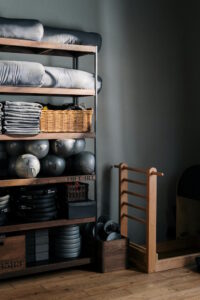
Pilates is a highly effective exercise method known for its ability to improve core strength, flexibility, and overall body awareness. While Pilates can be performed using just a mat, incorporating specialized equipment can enhance the practice and provide additional benefits. In this comprehensive guide to Pilates equipment, we’ll explore the various types of equipment used in Pilates, the reasons for using them, how they work, and the importance of small equipment in Pilates.
What Equipment is Used for Pilates?
Pilates equipment comes in a variety of forms, each designed to target different aspects of fitness and offer varying levels of support. Some of the most commonly used Pilates equipment include:
1. Reformer: The Pilates reformer is perhaps the most iconic piece of equipment. It consists of a sliding carriage attached to a frame with springs of varying resistance. Practitioners can perform a wide range of exercises on the reformer to improve strength, flexibility, and balance.
2. Cadillac or Trapeze Table: The Cadillac, also known as the Trapeze Table, features a bed-like platform with a canopy of bars, straps, and springs. It allows for a diverse range of exercises and can be particularly useful for those recovering from injuries.
3. Wunda Chair: The Wunda Chair is a compact piece of equipment with a seat and pedals. It is excellent for developing core strength, balance, and coordination.
4. Barrel: Pilates barrels, which include the spine corrector, ladder barrel, and arc barrel, provide support for various stretching and strengthening exercises, particularly those targeting the back and spine.
5. Pilates Ring (Magic Circle): This small, flexible ring provides resistance for both upper and lower body exercises, helping improve muscle tone and strength.
6. Small Equipment: Pilates also incorporates small equipment like foam rollers, resistance bands, and balls to add variety and challenge to exercises.
Why Use Pilates Equipment?
Pilates equipment offers several advantages that enhance the effectiveness of Pilates practice:
1. Variable Resistance: Equipment like the reformer and Cadillac feature adjustable springs, allowing for precise resistance levels tailored to individual needs. This makes it possible to progress gradually and accommodate different fitness levels.
2. Support and Alignment: Equipment often provides support and guidance for proper alignment during exercises. This reduces the risk of injury and ensures that movements are performed correctly.
3. Versatility: Pilates equipment offers a wide range of exercise possibilities, making it suitable for people with various fitness goals and abilities. The versatility of equipment allows for targeted workouts and rehabilitation.
4. Enhanced Core Activation: Many Pilates machines, such as the reformer and Wunda chair, engage the core muscles effectively, facilitating a more intense core workout compared to mat exercises alone.
5. Rehabilitation: Pilates equipment is frequently used in physical therapy and rehabilitation settings. It can aid in recovery from injuries, surgeries, and chronic conditions by providing controlled and gentle resistance.
How Does Pilates Equipment Work?
Pilates equipment operates on the principles of resistance and controlled movement. Springs of varying tension are commonly used to create resistance, and practitioners work against this resistance to perform exercises. The equipment provides support and alignment guidance, ensuring that movements are precise and controlled.
For example, on a Pilates reformer, the practitioner may perform exercises like leg presses or chest expansions by pushing or pulling against the resistance of the springs. The equipment’s design facilitates smooth and controlled motion while engaging the core and other muscle groups.
Why Use Small Equipment in Pilates?
Small equipment in Pilates, such as foam rollers, resistance bands, and balls, serves several purposes:
1. Variety: Small equipment adds diversity to Pilates workouts, preventing monotony and keeping practitioners engaged.
2. Challenge: These accessories can increase the intensity of exercises by adding resistance or instability, providing a greater challenge for muscles.
3. Targeted Workouts: Small equipment can target specific muscle groups or areas of the body, allowing for focused strengthening and stretching.
4. Improved Flexibility: Tools like foam rollers are used for self-myofascial release, aiding in muscle recovery and enhancing flexibility.
Incorporating small equipment into Pilates routines can help individuals achieve a well-rounded and effective workout that addresses their unique fitness goals.
Summarizing the Answers
In summary, Pilates equipment plays a significant role in enhancing the effectiveness and versatility of Pilates practice. Various types of equipment cater to different needs and abilities, offering variable resistance, support, and alignment. This equipment operates based on the principles of resistance and controlled movement, facilitating precise and targeted exercises. Additionally, small equipment in Pilates adds variety, challenge, and the opportunity for targeted workouts, making Pilates a comprehensive and adaptable exercise method suitable for individuals with diverse fitness goals and abilities.